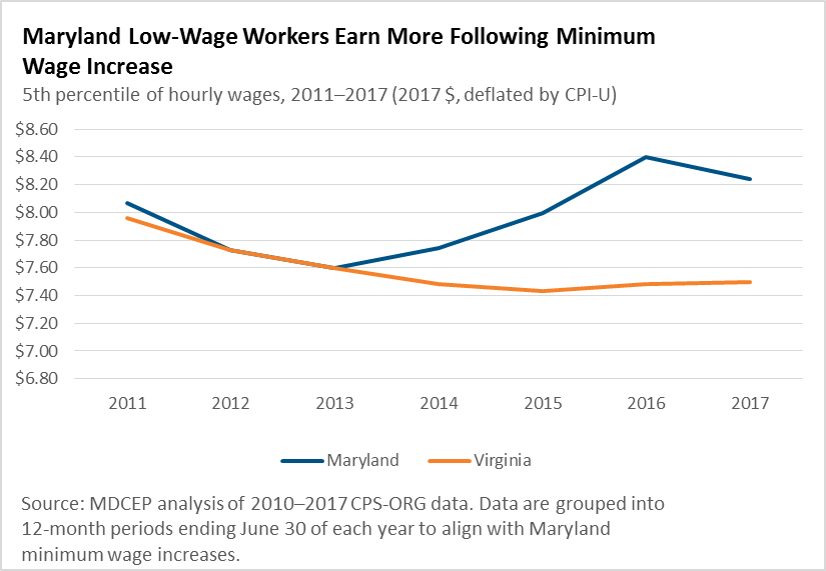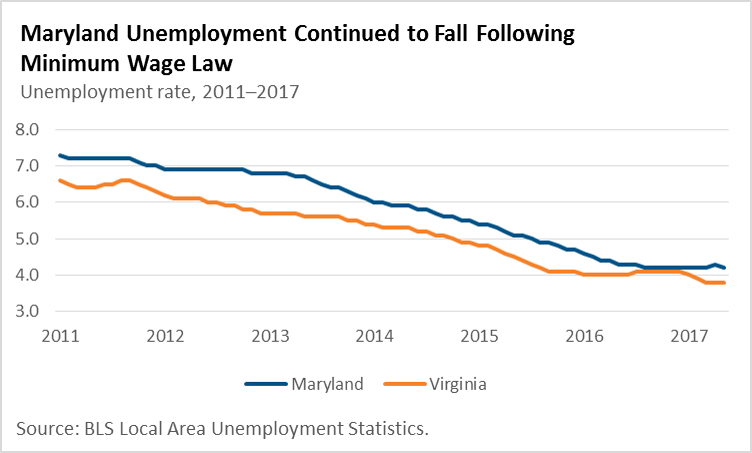Scheduled Minimum Wage Bump Helps Working Marylanders, Doesn’t Go Far Enough
Many of Maryland’s lowest-paid workers will get a pay raise Saturday thanks to a scheduled increase in the state’s minimum wage to $9.25 per hour (though tipped workers will still languish at $3.63 per hour). This is the second-to-last in a series of increases called for under a 2014 law, which will bring Maryland’s wage floor to $10.10 by this time next year. For thousands of hardworking Maryland families, this law means more money for things like groceries and school supplies, which translates into stronger sales at local businesses. At the same time, $10.10 is not sufficient for even a single adult working full time to afford a basic standard of living anywhere in the state, let alone those raising children. We should celebrate this week’s increase and continue to work toward a statewide standard of $15 per hour.
Maryland’s Wage Law Is Working as Intended
While Maryland has raised its minimum wage by $2 since 2014, Virginia’s wage floor is still equal to the federal standard at $7.25. This comparison is instructive, as the two states are nearby and economically similar. Low-wage workers in Maryland today earn about 6 percent more than they did when the state’s law was passed in 2014 (adjusted for inflation), while their counterparts in Virginia earn no more now than in 2014. During the same period, Maryland’s unemployment rate fell at the same pace as Virginia’s, suggesting that Maryland’s minimum wage law is working as intended.


This pattern is consistent with the bulk of high-quality research on state and local minimum wage laws. In places like San Francisco, Santa Fe, and counties along state borders, careful analysis has shown that higher wage floors have translated into a better standard of living for workers without increasing unemployment. A recent study of Seattle’s minimum wage replicated these findings. After the city’s pay standard increased to $13 per hour, restaurant workers took home bigger paychecks, while the number of jobs available wasn’t affected. Another study out of Seattle received media attention because of its more mixed results—slower growth in low-wage jobs than in other parts of the state, plus faster growth in middle-wage jobs that most researchers agree aren’t usually affected by the minimum wage. However, methodological issues with this study have raised doubts about the validity of its conclusions. On the whole, the body of high-quality research continues to indicate that the benefits of raising the minimum wage outweigh any costs.
Maryland Can Do More to Support Workers
The upcoming increase in Maryland’s minimum wage and next year’s scheduled increase to $10.10 are important steps forward for the state’s working families. We should continue this progress by raising the minimum wage to $15 over several years, establishing automatic increases to keep up with overall economic growth, and putting tipped workers on a level playing field. Legislators in both houses of the General Assembly introduced bills to do this in the 2017 session, and similar proposals came close to passage in Montgomery County and Baltimore City. Policymakers should make it a priority to ensure every job in Maryland pays a family-sustaining wage when the legislature reconvenes next year.
